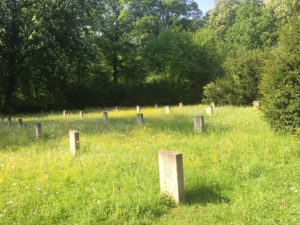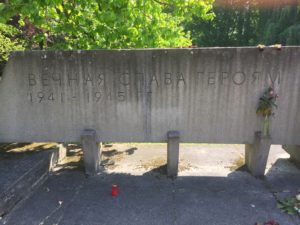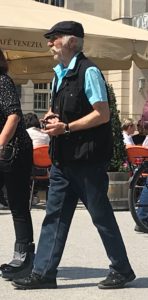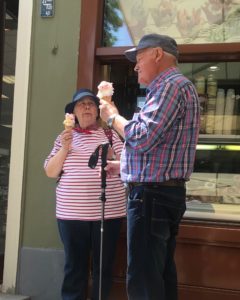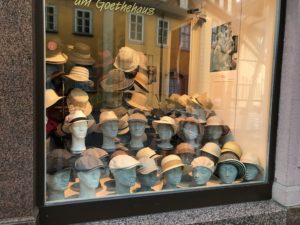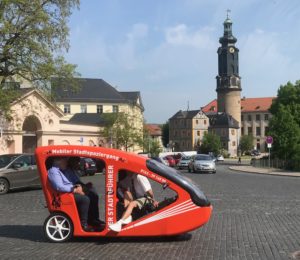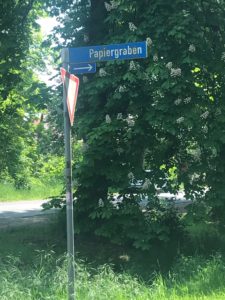In which Sid and Doris visit the house of the Widow Anna Amalia and the Hohe Pappeln arhitect’s home though not the Bauhaus Museum to which people are flocking.Weimar is not much bigger than Bishop’s Stortford by population, 50,000ish. By its role in cultural and political history it is huge and a one day visit does not do it justice.
Weimar was the capital of the Duchy of Saxe Weimar Eisenach. To get the general name drop and instant history out early here goes:
-Bach was the court organist in the early 18C
– Goethe was adviser to the regent Anna Amelia and her son, Carl August, when he came to rule
– The court at this little Duchy employed Schiller, Herder, Wieland
– Liszt becomes Ducal court conductor mid19C and premiered Wagner’s Lohengrin here
– Richard Strauss was under conductor of the court orchestra in late 19C
– Nietzsche lived his last years here, but not before setting out some ideas unfortunate for the region
– The Weimar Republic had its capital here because in 1919 Berlin was in a state of civil war
– In 1923 1 US Dollar would buy 4,210,500,000,000 German Marks
– Walter Gropius set up the Bauhaus School, now mostly associated with architecture
– Despite interesting theories about design and life Weimar became a centre of Nazism
– The first concentration camps were set up around Weimar, as early as 1933
– By 1945 Buchenwald had processed about 250,000 people of whom about 50,000 were killed on the spot, while others were sent on to die somewhere else
– By 1945 about 25% of the German workforce was slave labour, many worked to death
– The US 80th Infantry took Weimar and ordered the residents to walk through Buchenwald, just outside the town
– The town became part of the Soviet Zone. Not to waste captured resources the camp became Special Camp Number 2, processing about 28,000 inmates mainly National Socialists of whom 7,000 were killed by the Russians
– It seems a poor journey from Bach’s Sheep May Safely Graze to hosting human abattoirs.
Sid and Doris started the day through the park that Goethe laid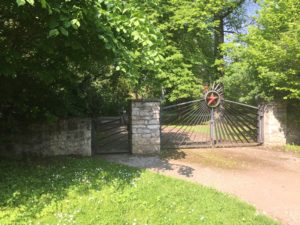 out along the Ilm. We saw the Romische Haus, a modest home in the shape of a Roman temple. Still in the park we found a Soviet war cemetery with about 640 graves, with stone memorial all behind a hammer and sickle gate with its own Red Star. No idea how they ended up here, no plaque and not on the town plan.
out along the Ilm. We saw the Romische Haus, a modest home in the shape of a Roman temple. Still in the park we found a Soviet war cemetery with about 640 graves, with stone memorial all behind a hammer and sickle gate with its own Red Star. No idea how they ended up here, no plaque and not on the town plan.
At breakfast we were fortunate to fall in with two friends who had known one another since school days, one born in Vienna and the other a German. Each year they have a week together somewhere. While the town is full of visitors to the Bauhaus Museum, opened this year, their top tip was the house of Anna Amalia, widowed at 18 with two children on the death of the Duke of Saxe-Weimar-Eisenach. She was a capable regent who was able to call in help from her own Brunswick family.
The house is not as grand as a Chatsworth. The tour helped us understand the Golden Age of the town and Anna Amalia’s role in the art, music, science and politics of the period. There are more Bauhaus houses in London than Weimar so this felt a great use of our morning, topped off with ice cream.
Sid and Doris do enjoy a Jugendstil or Art Nouveau house. So on the bus (you have to use public transport when on an Epic Journey) to Hohe Pappeln, which means High Poplars – because when it was built it was out in the country. I remember when this was all fields. This was the house that Belgian Henry van de Velde built for his family in 1908, though he was expelled during WW1. It is all of a piece with his interior decor and furniture much of it built in. Sid and Doris delighted to see pocket doors and interconnecting spaces just like home, but maybe bigger. It changed hands for the price of a potato during the Weimar inflation. Given local conditions it is surprisingly intact though we could only visit the main living floor.
Car diary is weak today. A Mercedes convertible is woofing about just behind us and the only competition is a Morgan Plus 8 in the hotel garage.
The birdy count includes a jay, a robin and dogfighting swifts. We have also spotted some quite good moustaches though these should probably fall under a new category of Local Colour. To which I can immediately add two stroke mopeds, long past in the UK on grounds of noise and smell. Miftah Bat, are you listening?
We are staying in The Leonardo which has been OK, though the waiting time for beer is astonishing in a country with 1,300 breweries. Still, they are part of the Bett and Bike marketing scheme and cheerfully gave us a bucket and cloth to clean the bikes. Six days on the road (loosely defined) had left them looking a bit shabby. But now they are ready to go again. Sid and Doris have a general outline for a four day trip to Prague. Next step, find beer, and find mapping though probably better in the other order.
[We really did take an odd collection of photos today. Here are a few more, including one which you may want to keep next to your computer printer – D.]
